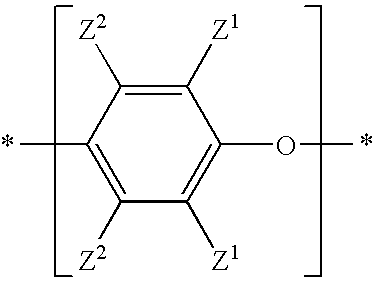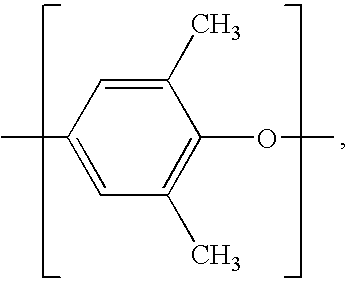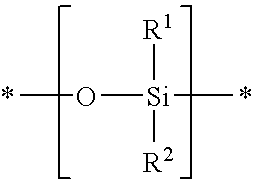Poly(arylene ether)-polysiloxane composition and method
- Summary
- Abstract
- Description
- Claims
- Application Information
AI Technical Summary
Benefits of technology
Problems solved by technology
Method used
Image
Examples
examples 1-10
COMPARATIVE EXAMPLES 1-7
[0077]These examples, which were conducted on a laboratory scale, illustrate the effects of several process variables on product characteristics.
[0078]The following materials were used in the block copolymer synthesis: 2,6-dimethylphenol was obtained from SABIC Innovative Plastics LLP; N,N-dimethyl-n-butylamine (DMBA), N,N′-di-tert-butyl-ethylenediamine (DBEDA), and di-n-butylamine (DBA) were obtained from Celanese Ltd.; Cuprous Oxide (Cu2O) was obtained from American Chemet Corporation; a phase transfer agent was obtained as Maquat 4450T from Mason Chemical Company; hydrobromic acid (HBr) was obtained from Diaz Chemical Corporation; toluene was obtained from Ashland; trisodium nitrilotriacetate (NTA) was obtained from Akzo Nobel Functional Chemicals LLC; eugenol-capped siloxane fluids were obtained from Momentive Performance Materials.
[0079]Component amounts for a representative reaction mixture are given in Table 1, where the flow rate units of standard cu...
examples 11-17
[0090]These examples, which were conducted on a pilot plant scale, illustrate the effects of several process variables on the product characteristics of the block copolymer product.
[0091]The process variations are summarized in Table 3 and are the same as those described above for Table 2.
[0092]The process variations were superimposed on the following general synthetic procedure. The reactor and the 2,6-dimethylphenol addition tank were rinsed with warm toluene to assure their cleanliness. The reaction was purged with nitrogen to achieve an oxygen concentration of less than 1%. The reactor was charged with initial toluene (fresh or recycled), and this toluene was stirred at 500 rotations per minute (rpm). The temperature of the initial toluene was adjusted to the “initial charge” temperature specified in Table 2 and maintained at that temperature during addition of the initial charge of 2,6-dimethylphenol from the addition tank to the reaction vessel. After the addition of the initi...
examples 18 and 19
[0096]These examples illustrate the effect of precipitation antisolvent type on the final properties of the isolated product.
[0097]The reaction conditions for Examples 18 and 19 were the same as those for Example 17 as shown in Table 3, except that the reaction mixture and chelant solution were separated via liquid-liquid centrifuge rather than separatory funnel. Example 18 used precipitation in methanol, while Example 19 used precipitation in isopropanol. Characterization of the isolated products is summarized in Table 5. The results show a higher weight percent siloxane in the methanol-precipitated sample than the isopropanol-precipitated sample, which is consistent with the observation that isopropanol is a significantly better solvent for the hydroxyaryl-terminated polysiloxane than is methanol. Thus, precipitation with isopropanol can be an effective means of minimizing residual hydroxyaryl-terminated polysiloxane in the isolated product.
TABLE 5Ex. 18Ex. 19Intrinsic viscosity (...
PUM
| Property | Measurement | Unit |
|---|---|---|
| Temperature | aaaaa | aaaaa |
| Percent by mass | aaaaa | aaaaa |
| Percent by mass | aaaaa | aaaaa |
Abstract
Description
Claims
Application Information
 Login to View More
Login to View More - R&D
- Intellectual Property
- Life Sciences
- Materials
- Tech Scout
- Unparalleled Data Quality
- Higher Quality Content
- 60% Fewer Hallucinations
Browse by: Latest US Patents, China's latest patents, Technical Efficacy Thesaurus, Application Domain, Technology Topic, Popular Technical Reports.
© 2025 PatSnap. All rights reserved.Legal|Privacy policy|Modern Slavery Act Transparency Statement|Sitemap|About US| Contact US: help@patsnap.com



